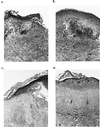Expression of sialylated or paragloboside-like lipooligosaccharides are not required for pustule formation by Haemophilus ducreyi in human volunteers
- PMID: 10569746
- PMCID: PMC97038
- DOI: 10.1128/IAI.67.12.6335-6340.1999
Expression of sialylated or paragloboside-like lipooligosaccharides are not required for pustule formation by Haemophilus ducreyi in human volunteers
Abstract
The lipooligosaccharide (LOS) of Haemophilus ducreyi, the etiologic agent of chancroid, chemically and immunologically resembles human glycosphingolipid antigens. To test whether LOS that contains paragloboside-like structures was required for pustule formation, an isogenic mutant (35000HP-RSM2) was constructed in losB, which encodes D-glycero-D-manno-heptosyltransferase. 35000HP-RSM2 produces a truncated LOS whose major glycoform terminates in a single glucose attached to a heptose trisaccharide core and 2-keto-3-deoxyoctulosonic acid. Five human subjects were inoculated with 35000HP and 35000HP-RSM2 in a dose-response trial. For estimated delivered doses (EDDs) of >/=25 CFU, the pustule formation rates were 80% for 35000HP and 58% for 35000HP-RSM2. Preliminary data indicated that a previously described Tn916 losB mutant made a minor glycoform that does not require DD-heptose to form the terminal N-acetyllactosamine. If 35000HP-RSM2 made this glycoform, then 35000HP-RSM2 could theoretically make a sialylated glycoform. To test whether sialylated LOS was required for pustule formation, a second trial comparing an isogenic sialyltransferase mutant (35000HP-RSM203) to 35000HP was performed in five additional subjects. For EDDs of >/=25 CFU, the pustule formation rates were 30% for both 35000HP and 35000HP-RSM203. The histopathology and recovery rates of H. ducreyi from surface cultures and biopsies obtained from mutant and parent sites in both trials were similar. These results indicate that neither the expression of a major glycoform resembling paragloboside nor sialylated LOS is required for pustule formation by H. ducreyi in humans.
Figures


Similar articles
-
Haemophilus ducreyi lipooligosaccharide mutant defective in expression of beta-1,4-glucosyltransferase is virulent in humans.Infect Immun. 2001 Jun;69(6):4180-4. doi: 10.1128/IAI.69.6.4180-4184.2001. Infect Immun. 2001. PMID: 11349097 Free PMC article.
-
A DltA mutant of Haemophilus ducreyi Is partially attenuated in its ability to cause pustules in human volunteers.Infect Immun. 2006 Feb;74(2):1394-7. doi: 10.1128/IAI.74.2.1394-1397.2006. Infect Immun. 2006. PMID: 16428791 Free PMC article.
-
Expression of peptidoglycan-associated lipoprotein is required for virulence in the human model of Haemophilus ducreyi infection.Infect Immun. 2000 Nov;68(11):6441-8. doi: 10.1128/IAI.68.11.6441-6448.2000. Infect Immun. 2000. PMID: 11035757 Free PMC article.
-
Interactions of the Skin Pathogen Haemophilus ducreyi With the Human Host.Front Immunol. 2021 Feb 3;11:615402. doi: 10.3389/fimmu.2020.615402. eCollection 2020. Front Immunol. 2021. PMID: 33613541 Free PMC article. Review.
-
Chancroid: from clinical practice to basic science.AIDS Patient Care STDS. 2000 Jan;14(1):19-36. doi: 10.1089/108729100318109. AIDS Patient Care STDS. 2000. PMID: 12240879 Review.
Cited by
-
A humoral immune response confers protection against Haemophilus ducreyi infection.Infect Immun. 2003 Dec;71(12):6971-7. doi: 10.1128/IAI.71.12.6971-6977.2003. Infect Immun. 2003. PMID: 14638786 Free PMC article.
-
Formate production is dispensable for Haemophilus ducreyi virulence in human volunteers.Infect Immun. 2023 Sep 14;91(9):e0017623. doi: 10.1128/iai.00176-23. Epub 2023 Aug 18. Infect Immun. 2023. PMID: 37594273 Free PMC article.
-
A (p)ppGpp-null mutant of Haemophilus ducreyi is partially attenuated in humans due to multiple conflicting phenotypes.Infect Immun. 2014 Aug;82(8):3492-502. doi: 10.1128/IAI.01994-14. Epub 2014 Jun 9. Infect Immun. 2014. PMID: 24914217 Free PMC article.
-
Transcription of candidate virulence genes of Haemophilus ducreyi during infection of human volunteers.Infect Immun. 2001 Mar;69(3):1483-7. doi: 10.1128/IAI.69.3.1483-1487.2001. Infect Immun. 2001. PMID: 11179316 Free PMC article.
-
Characterization of Haemophilus ducreyi-specific T-cell lines from lesions of experimentally infected human subjects.Infect Immun. 2001 Jul;69(7):4224-31. doi: 10.1128/IAI.69.7.4224-4231.2001. Infect Immun. 2001. PMID: 11401958 Free PMC article.
References
-
- Al-Tawfiq, J., J. Harezlak, B. P. Katz, and S. M. Spinola. Cumulative experience with Haemophilus ducreyi in the human model of experimental infection. Sexually Trans. Dis., in press. - PubMed
-
- Al-Tawfiq J A, Thornton A C, Katz B P, Fortney K R, Todd K D, Hood A F, Spinola S M. Standardization of the experimental model of Haemophilus ducreyiinfection in human subjects. J Infect Dis. 1998;178:1684–1687. - PubMed
-
- Al-Tawfiq, J. A., M. E. Bauer, K. R. Fortney, B. P. Katz, A. F. Hood, M. Ketterer, M. A. Apicella, and S. M. Spinola. Submitted for publication.
-
- Al-Tawfiq, J. A., K. R. Fortney, B. P. Katz, C. Elkins, and S. M. Spinola. Submitted for publication.
Publication types
MeSH terms
Substances
Grants and funding
LinkOut - more resources
Full Text Sources

